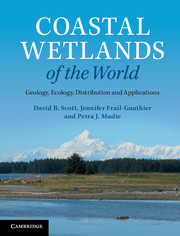Book contents
- Frontmatter
- Contents
- Preface
- List of acronyms and abbreviations
- 1 Introduction: what is covered in this coastal wetlands book?
- 2 Physical aspects: geological, oceanic and climatic conditions
- 3 Zonations and plants: development, stressors and adaptations
- 4 Animals in coastal wetlands: zonation, adaptations and energy flow
- 5 Human intervention causing coastal problems
- 6 Coastal wetlands worldwide: climatic zonation, ecosystems and biogeography
- 7 Examples of North American salt marshes and coastal wetlands
- 8 Examples of South American coastal wetlands
- 9 Africa: selected marsh and mangrove areas
- 10 Europe and Asia: a view of what remains
- 11 Australasia: wetlands of Australia and New Zealand
- 12 Applications in geological monitoring: paleoseismology and paleoclimatology
- 13 Applications in conservation of plant biodiversity and agriculture
- 14 Using mesocosms as a way to study coastal wetlands
- 15 Conclusions and future directions
- References
- Index
- Plate section
2 - Physical aspects: geological, oceanic and climatic conditions
Published online by Cambridge University Press: 05 July 2014
- Frontmatter
- Contents
- Preface
- List of acronyms and abbreviations
- 1 Introduction: what is covered in this coastal wetlands book?
- 2 Physical aspects: geological, oceanic and climatic conditions
- 3 Zonations and plants: development, stressors and adaptations
- 4 Animals in coastal wetlands: zonation, adaptations and energy flow
- 5 Human intervention causing coastal problems
- 6 Coastal wetlands worldwide: climatic zonation, ecosystems and biogeography
- 7 Examples of North American salt marshes and coastal wetlands
- 8 Examples of South American coastal wetlands
- 9 Africa: selected marsh and mangrove areas
- 10 Europe and Asia: a view of what remains
- 11 Australasia: wetlands of Australia and New Zealand
- 12 Applications in geological monitoring: paleoseismology and paleoclimatology
- 13 Applications in conservation of plant biodiversity and agriculture
- 14 Using mesocosms as a way to study coastal wetlands
- 15 Conclusions and future directions
- References
- Index
- Plate section
Summary
Key points
Coastal wetlands exist on the edge of all continents except Antarctica; saltwater wetlands are covered by seawater daily or periodically; tidal range and period (once or twice/day) control the amount of submergence and oxygen supply to marsh biota; tidal vegetation includes halophytic salt marshes, mangroves, seagrass beds and brackish water reed-swamps; salt marshes dominate cooler regions (>30° latitude) and mangroves occupy equatorial regions; local variations follow salt gradients measured as parts per mille or dimensionless psu; coastal wetlands develop in wave-sheltered sites: estuaries, deltas, glaciated fiords, barrier lagoons and tectonic down-faults; sediment supply must compensate for erosion by storm tides (cyclones, hurricanes, typhoons); space is also needed for growth on emerging or submerging coasts; global-warming impacts and human population growth are increasing risks of flooding and erosion.
What are coastal wetlands (saltwater wetlands)?
The Ramsar Convention defines wetlands as areas of marsh, fen or peatland with water which is static or flowing, fresh, brackish or salt, including areas of marine water not deeper than 6 m. Coastal wetlands, however, exist only at the interface of the land and sea, occurring on shorelines marked by some degree of tidal inundation, i.e. the tidal marshes and mangrove swamps, as classified in Mitsch and Gosselink (2007), who provide a dictionary of the many terms used to classify wetlands. All saltwater wetlands are characterized by the presence of brackish or saline water derived from the mixing of marine and fresh waters – including salt marshes, mangroves, seagrass beds and brackish water reed-swamps. Of this suite of intertidal habitats, the best known is the salt marsh, which is the most accessible saltwater wetland and the focus of many classical ecological studies which began over 100 years ago, starting in 1903 in North America (Ganong, 1903) and 1917 in Wales (Doody, 2008).
- Type
- Chapter
- Information
- Coastal Wetlands of the WorldGeology, Ecology, Distribution and Applications, pp. 5 - 16Publisher: Cambridge University PressPrint publication year: 2014
- 1
- Cited by



